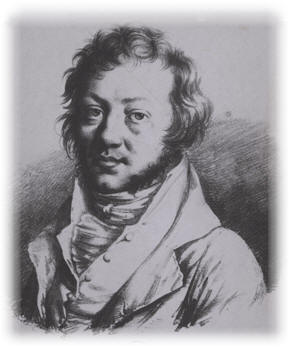When it comes to electricity, the most basic foundation is U=I*R. The unit of current I, A/Ampere, is the unit of today's protagonist, André-Marie Ampère. Next AOMAG Magnetics tells the story of the Ampere.
 André-Marie Ampère (1775-1836), was a French physicist, natural philosopher, and mathematician who is best known for his important contributions to the study of electrodynamics. He invented the astatic needle, a critical component of the modern astatis galvanometer, and was the first to demonstrate that a magnetic field is generated when two parallel wires are charged with electricity. He is generally credited as one of the first to discover electromagnetism. Born January 20, 1775, Ampère was the son of a successful businessman and local government official in Polemieux-auMont-d'Or, a small community near Lyon, France. As a child Ampere spent a great deal of time reading in the library of his family home, and he voraciously consumed books of history, geography, literature, philosophy and the natural sciences. His father taught him Latin and encouraged Ampère to pursue his passion for mathematics. Some historians write that the young Ampère was a math prodigy at a very early age and that he used to work out long mathematical formulas, just for his own personal entertainment, using small pebbles or breadcrumbs to represent groups of numbers.
André-Marie Ampère (1775-1836), was a French physicist, natural philosopher, and mathematician who is best known for his important contributions to the study of electrodynamics. He invented the astatic needle, a critical component of the modern astatis galvanometer, and was the first to demonstrate that a magnetic field is generated when two parallel wires are charged with electricity. He is generally credited as one of the first to discover electromagnetism. Born January 20, 1775, Ampère was the son of a successful businessman and local government official in Polemieux-auMont-d'Or, a small community near Lyon, France. As a child Ampere spent a great deal of time reading in the library of his family home, and he voraciously consumed books of history, geography, literature, philosophy and the natural sciences. His father taught him Latin and encouraged Ampère to pursue his passion for mathematics. Some historians write that the young Ampère was a math prodigy at a very early age and that he used to work out long mathematical formulas, just for his own personal entertainment, using small pebbles or breadcrumbs to represent groups of numbers.
Even without any formal education Ampère began a career as a science teacher. After teaching for a while in Lyon he accepted positions at institutions of higher learning including the College of France and the Polytechnic School at Paris, where he was a professor of mathematics. It was there that he first conducted important research and experiments into the nature of electrical and magnetic forces. In the early 1820s, after learning about the electromagnetism experiments of Hans Christian Oersted, Ampère began to formulate a combined theory of electricity and magnetism, doing several demonstrations involving magnetic and electrical forces. His work confirmed and validated the discoveries of Oersted while also expanding upon them, helping to accelerate work in the field of electromagnetism around the world.
Ampère's most significant scholarly paper on the subject of electricity and magnetism, titled Memoir on the Mathematical Theory of Electrodynamic Phenomena, was published in 1826. The theoretical foundation presented in this publication served as the basis for other ideas of the 19th century regarding electricity and magnetism. It helped to inspire research and discoveries by scientists including Faraday, Weber, Thomson, and Maxwell.
Ampère was elected to the prestigious National Institute of Sciences in 1814, and was awarded a chair at the University of France in 1826. There he taught electrodynamics and remained a member of the faculty until his death. He was also a member of the Fellows of the Royal Society of London
Despite his celebrated accomplishments, Ampère led a rather tragic life. When Lyons was taken over by rebels during the French Revolution, his beloved father was a district judge. Because of his political affiliations, Ampère's father was taken as a political prisoner and then publicly executed by guillotine, an event that severely scarred the young Ampère and led to a period of psychological depression. Later in life Ampère's first wife met with an early death after a prolonged illness, and although he remarried, his second marriage was unhappy and unsuccessful.
Ampère died June 10, 1836 in Marseilles, France, and was buried in the Montmartre Cemetery in Paris. When Gustave Eiffel built his famous Eiffel Tower in Pairs in 1889, he included the names of 72 prominent French scientists on plaques around the first section at the base of the structure. The name of André-Marie Ampère is included in that distinguished memorial.
The ampere – the unit for measuring electric current – was named in honor of Ampère. In the past, an ampere was understood as the force generated between parallel electrically charged wires, but as scientific knowledge evolves over time, the definition of "ampere" sometimes changes slightly also. The current modern definition of ampere describes the ability of a specified current to deposit a precise amount of a substance on an electrode during electrolysis.
Ampere synthesized his research in a book, The Mathematical Theory of Electrodynamic Phenomena, which became an important classic treatise in the history of electromagnetism. Ampere was also the first person to develop the technology of measuring electricity, and he used a self-rotating magnetic needle to make an instrument for measuring electric current, which was later improved to be called an ammeter. Ampere in his life, only a short period of time engaged in physics work, but he was able to unique, thorough analysis, the magnetic effect of charged wires, so we call him the first creator of electrodynamics, he is deserved.





